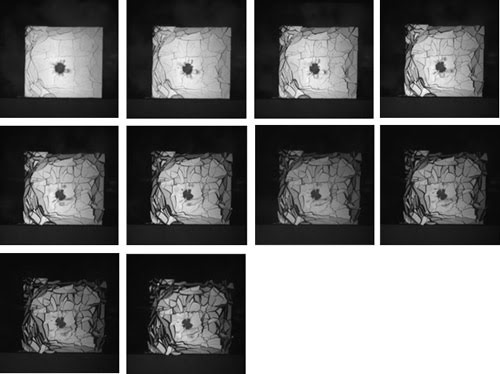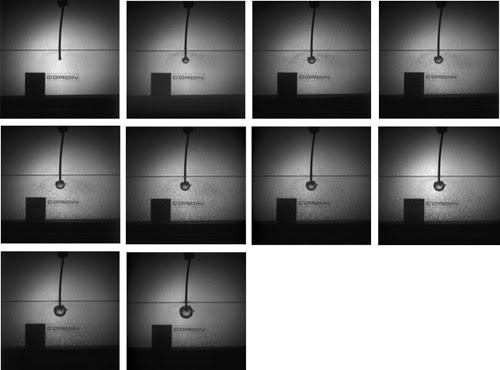CCD technology brings new capabilities to ultrahigh-speed imaging.
Nathan Nebeker, Cordin Co.
Historically, the fastest framing cameras have been rotating-mirror film cameras, which can capture many millions of frames per second with resolution and image quality that is usually limited by the film grain. As a research tool, they have been unparalleled in the rate at which they acquire image information.
Although CCDs have been available for quite some time, it is only recently that they passed the cost/performance threshold and became a legitimate replacement for film in rotating-mirror cameras. The speed of rotating-mirror technology and the convenience of electronic imaging make the combination of these technologies attractive. The ultimate performance of CCD systems is still not up to film camera standards, but the immediate availability of images and the systems’ increased flexibility make the trade-off worthwhile.
Rotating-mirror theory
The principle of the rotating mirror is that rather than moving the film to the light, as with a standard motion picture camera, you move the light to the film using a rotating mirror and a relay optical system. The film remains stationary in an arc that is centered above the mirror, which, as it rotates, produces a limited sequence of images (typically 40 to 80) on the film. Therefore, to limit the light entering the camera to one rotation of the mirror, square high-intensity light pulses are used for a duration of less than or equal to the mirror period.
To replace film with CCDs in these types of cameras, several conditions had to be met. First, the cost had to be below a reasonable threshold. Because these cameras require one CCD per frame, or up to 62 CCDs in a single camera, the expense is significant.

In these images, a Cordin 550-32 camera captured a high-energy (5 kV) explosive pulse detonated behind a microscope coverslip. The field of view is 1 in., the capture rate is 100,000 fps, and the interframe time is 10 μs.
The next consideration was the imaging performance of the CCDs. A typical image from a rotating-mirror film camera is 25 mm wide with a resolution of 65 line pairs per millimeter. If we assume two pixels per line pair, the equivalent resolution on a CCD is 3250 pixels. Although CCDs of this resolution and higher are available, they violate the cost constraints.
We chose a 1k × 1k CCD from Eastman Kodak Co. of Rochester, N.Y., partly because the optical resolution of the system needed to match the pitch of the CCD pixels. The device has 7-μm pixels, which means 1000 pixels over a 7-mm length. This corresponds to optical resolution of about 70 line pairs per millimeter, which is well within the capabilities of the rotating-mirror systems.
The other important factors we needed to evaluate were sensitivity and dynamic range. At top speeds, it’s typical to have exposure times down to a few hundred nanoseconds. Also, there are practical limits to how much light you can bounce off the subject. The CCDs had to have sensitivity equivalent to that of 400 ASA film, which the Kodak device does.
The dynamic range of the CCDs is never as good as film. The logarithmic response of film means that you can get meaningful image information over a very large range of light intensities. Because CCDs are linear in response, they will saturate under the same conditions. This means the user must pay closer attention to exposure settings, but the CCDs are capable of 10 to 12 bits of gray level within one image.
New approach to shuttering
The greatest challenge to adapting the CCDs was the electronic shuttering, but this also yielded some of the most interesting features of the system. With a film camera, the emulsion of the film is ready to react to any light it receives. The advantage of a CCD is that it can accumulate image information and then either dump it or transfer it, depending on a signal that takes only a few microseconds.

These selected images show a high-energy explosive pulse detonated in a water tank. The capture rate is approximately 50,000 fps, for an interframe time of 20 μs.
To coordinate the shuttering of the CCDs with the position of the rotating mirror, a laser synchronization system runs off the rotating mirror and indexes its position. The resulting timing sequence controls the shuttering of each CCD.
Light is delivered to a CCD when the rotating mirror faces it. The image is captured and held until just before the mirror faces that CCD again. If the system receives a command to save the image, the pixels are turned off and this information is transferred to the registers for output. If no such command is received, the CCD is wiped and is ready for the next image.
Illumination and timing
Because of the ease with which images are captured with CCD cameras and the ability to elect whether to save them or not, the user can be more casual about illumination and timing. With film cameras, it is important that the light source be off before the mirror comes around again to prevent double exposure, whereas CCDs can be turned off within a microsecond. Also, this trigger signal can occur before, during or after the event. With film cameras, it is necessary to generate a trigger signal some time before the event.
For example, when using a film system to take a high-speed picture of a bridge wire, which produces its own light, that light may very well last longer than one period of the mirror. Either the image will be double-exposed or, because mechanical shutters are not fast enough, the user will need a blast shutter, which is a mirror or window that is shattered with explosives immediately after the shot. The CCD system makes the process easier because it simply turns off electronically after the shot.
Although CCDs do not provide the same level of imaging performance as film in terms of resolution and especially of dynamic range, the immediate availability of images and the great increases in flexibility of lighting, timing and triggering have made them a compelling replacement in rotating-mirror camera systems.
Meet the author
Nathan Nebeker is director of marketing and sales at Cordin Co. in Salt Lake City; e-mail: [email protected].